Brown spots on teeth, or brown stains on teeth, are issues with dental health and aesthetics. Brown teeth arise from various factors, such as dietary habits, poor oral hygiene, and underlying health issues.
The primary causes include consuming staining foods and beverages like coffee, tea, red wine, and berries. Smoking and tobacco use contribute as nicotine and tar accumulate on the enamel. Tooth decay from poor oral hygiene and sugary foods leads to brown spots as enamel erodes. Tartar buildup, resulting from hardened plaque, appears yellow or brown. Excessive fluoride intake in childhood causes dental fluorosis, leading to brown spots. Other factors include enamel erosion from acidic foods, trauma to the teeth, and certain medications that cause intrinsic staining.
Professional teeth whitening treatments are effective for surface stains. In-office whitening involves a high-concentration bleaching gel and special light for fast results, while at-home trays offer gradual whitening. Laser whitening provides quicker and more dramatic results. Dental veneers, thin porcelain or composite resin shells, cover discolouration, offering a natural appearance. Dental crowns cap the entire visible tooth and are used for severe discolouration. Dental bonding applies tooth-coloured resin to mask mild to moderate brown spots.
Preventive measures include brushing and flossing to remove plaque, using fluoride toothpaste to strengthen enamel, and limiting the staining of foods and beverages. Using a straw for drinks, drinking water after meals, and eating crunchy fruits and vegetables all help keep teeth clean. Avoiding tobacco products is crucial. Consistent dental examinations and cleanings ensure the professional removal of plaque and tartar and the early finding of dental problems.
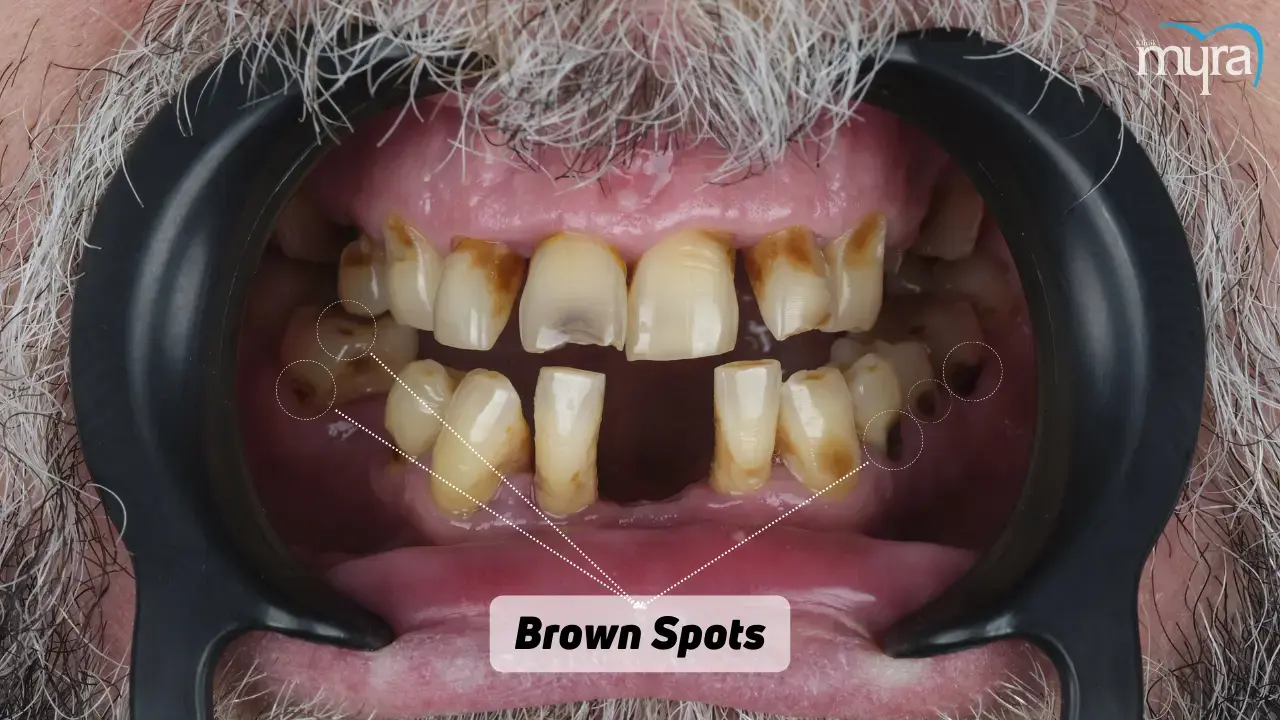
What are Brown Spots on Teeth?
Brown spots on teeth are areas of discolouration that manifest as patches or lines varying from yellowish-brown to black-brown. These spots differ in shape and size, appearing as irregular, blotchy patches, streaks, or speckles on the surface of the teeth. The appearance of brown spots on teeth ranges from tiny dots to larger, more noticeable areas that affect one or multiple teeth.
The texture of these spots varies. Some brown spots feel smooth and blend seamlessly with the surrounding enamel, while others are rough or pitted, indicating a more significant alteration of the tooth surface. The discolouration is superficial, affecting only the outermost layer of enamel, while in others, it penetrates deeper into the tooth structure. Tooth discolouration on teeth affects the aesthetics of a person's smile, leading to concerns about appearance and dental health. Identifying and addressing these spots is crucial for maintaining oral hygiene and enhancing the visual appeal of the teeth.
How does Brown Spots on Teeth Develop?
Brown spots on teeth develop due to various factors that affect the tooth enamel and underlying dentin. Tooth decay is a result of excessive consumption of sugary foods and drinks. It leads to plaque formation on the tooth surface, which, if left untreated, destroys the enamel and causes brown spots. Tartar buildup occurs when plaque hardens over time, appears yellow or brown and contributes to tooth discolouration (Stained teeth).
Ageing and enamel thinning are contributors to brown spots on teeth. The protective enamel wears down as people age, exposing the darker dentin layer underneath. Genetic factors and developmental conditions like dentinogenesis imperfecta impact enamel development and lead to discolouration. Certain medications, such as tetracycline antibiotics, cause staining in developing teeth, while excessive fluoride intake in children results in dental fluorosis, characterised by white, grey, or brown spots.
Additional factors include lifestyle choices and health conditions. Tobacco use, smoking and chewing lead to staining due to the nicotine and other compounds in tobacco products. Dark-pigmented foods and drinks, such as berries, red wine, and coffee, gradually stain the teeth. Celiac disease is associated with dental enamel defects, including sudden brown stains on teeth. Preventing and treating brown spots involves good oral hygiene, avoiding staining substances, and skilled oral health treatments like whitening, fillings, or veneers to address existing discolouration.
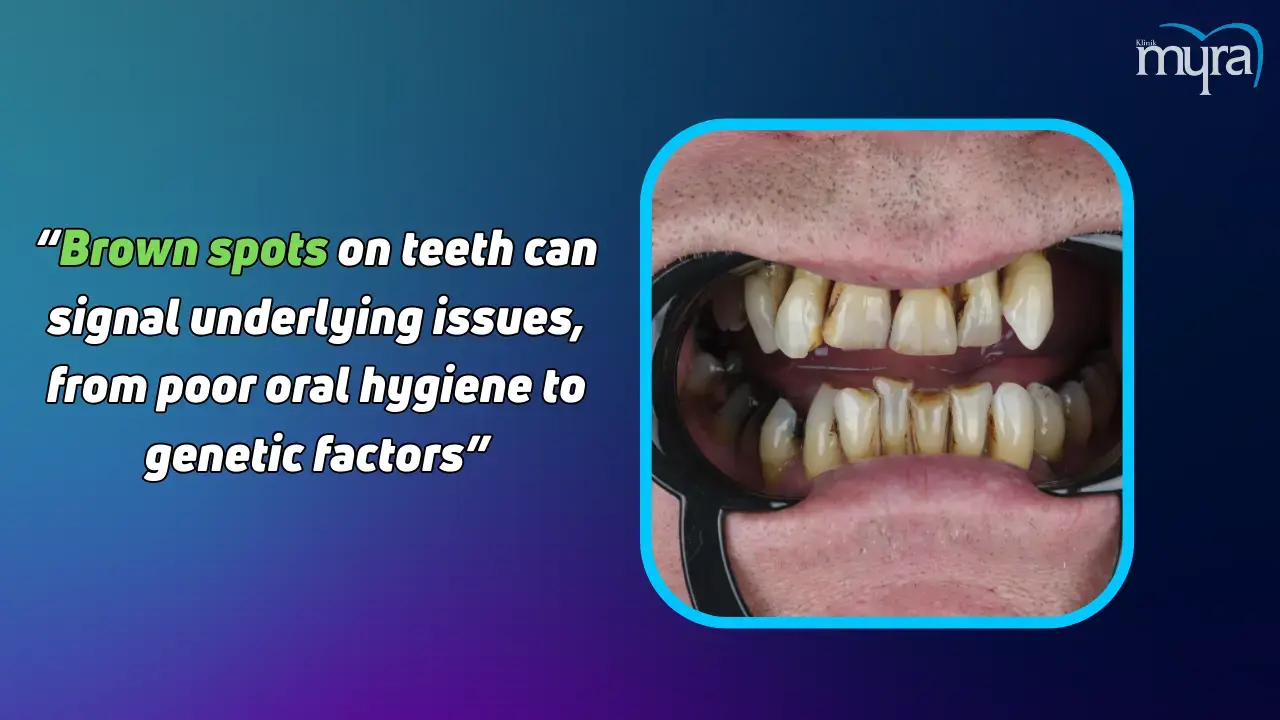
Who is at Risk of Developing a Brown Tooth?
Patients at risk of developing a brown tooth include people with certain lifestyle habits, health conditions, and genetic predispositions. One risk factor is the use of nicotine and tobacco products. The particles in tobacco adhere to the porous tooth enamel and accumulate over time, resulting in noticeable discolouration. Brown staining is a common cause and affects smokers and users of other tobacco products. The risk is heightened by poor oral hygiene, which allows the staining particles to remain on the teeth longer.
Consuming dark-coloured foods and beverages puts individuals at risk of developing brown spots on teeth. Foods and drinks like coffee, tea, red wine, and berries contain chromogens, chemicals that stain tooth enamel. Poor oral hygiene exacerbates the risk, as regular brushing and flossing help to remove these staining substances before they cause lasting discolouration. Repeated exposure to these chromogens leads to significant tooth staining.
Tooth decay is another critical risk factor for brown spots on teeth. Plaque and tartar bacteria produce acids that weaken and erode the tooth enamel, exposing the yellowish dentin layer underneath, which gives the appearance of brown spots or discolouration. A person's teeth get browner over time because the protective enamel wears away, making the underlying dentin more visible. Genetic and developmental factors such as dentinogenesis imperfecta and enamel hypoplasia cause inherent discolouration and abnormalities in the tooth structure, making individuals more susceptible to brown spots.
Antibiotics, like tetracycline, stain the teeth during childhood tooth development. Excessive fluoride intake during childhood leads to fluorosis, which manifests as white, grey, or brown spots on the teeth. Individuals with celiac disease notice tooth discolouration, including brown spots, as an early sign of an autoimmune disorder. Patients who smoke, have poor dental hygiene, consume staining foods and drinks, take certain medications, or have genetic or developmental conditions are at a higher risk of developing brown spots on their teeth.
How Common are Brown Teeth?
Brown teeth are common, and dietary habits, tobacco use, and oral hygiene influence their prevalence. Frequent consumption of staining foods and beverages like coffee, tea, red wine and smoking increases the likelihood of tooth discolouration. Poor oral hygiene contributes to brown stains due to plaque and tartar buildup. Regions with high fluoride levels in drinking water report higher dental fluorosis rates, which appear as brown spots on teeth. Environmental factors and lifestyle choices play roles in the commonality of brown teeth.
Are Brown Teeth Common in Children?
No, brown teeth are not common in children. Brown teeth in children are concerning under certain circumstances. Parents must pay attention if the brown stains on baby teeth persist or worsen over time. Brown stains that appear suddenly are a cause for concern, mainly if they include other symptoms like pain, sensitivity, or swelling.
Injury or trauma to the teeth causing discolouration, along with poor dental hygiene leading to plaque buildup and tartar formation, must be addressed quickly. Consulting a dentist is crucial if a child has experienced a fall or impact that has damaged the nerves in their teeth or if there are signs of dental decay.
Professional advice is necessary if brown stains are linked to medications or health conditions like celiac disease. Regular dental check-ups every six months help monitor tooth colour and oral health, ensuring any emerging issues are caught and treated early. Persistent, sudden, or symptomatic brown stains on baby teeth must prompt a visit to the dentist.
What are the Causes of Brown Spots on Teeth?
The causes of Brown Spots on Teeth are listed below.
- Smoking: The inhalation and use of tobacco products. Smoking leads to the buildup of nicotine and tar on tooth enamel, which adheres to the porous surface and results in persistent brown stains.
- Foods and Beverages: Consumption of dark-coloured foods and drinks. Berries, sauces, and beverages such as coffee, tea, and red wine contain chromogens and tannins that stain tooth enamel, leading to brown spots over time.
- Tooth Decay: Tooth decay is tooth enamel decay caused by bacterial activity. Plaque bacteria produce acids that erode enamel, exposing the yellowish dentin underneath and causing brown spots as the decay progresses.
- Tartar: Tartar is a hardened plaque that has calcified on teeth. Plaque hardens into tartar if not brushed and flossed regularly. Tartars turn yellow or brown and cause tooth discolouration.
- Fluorosis: Excessive intake of fluoride during tooth development. High fluoride exposure in children under eight leads to dental fluorosis, manifesting as white, grey, or brown spots on teeth.
- Teeth Trauma: Teeth trauma is a physical injury to the teeth. Trauma from falls or impacts damages a tooth's nerves or blood supply, including brown or grey spots, leading to discolouration.
- Enamel Erosion: Enamel erosion is the wearing away of the tooth's protective enamel layer. Acidic foods, drinks, and stomach acids from conditions like acid reflux erode enamel, exposing the darker dentin beneath and causing brown spots.
- Ageing: The natural ageing process affects dental health. The enamel wears down, and the underlying dentin, which becomes more yellow or brown over time, becomes more visible, leading to a darker appearance of teeth.
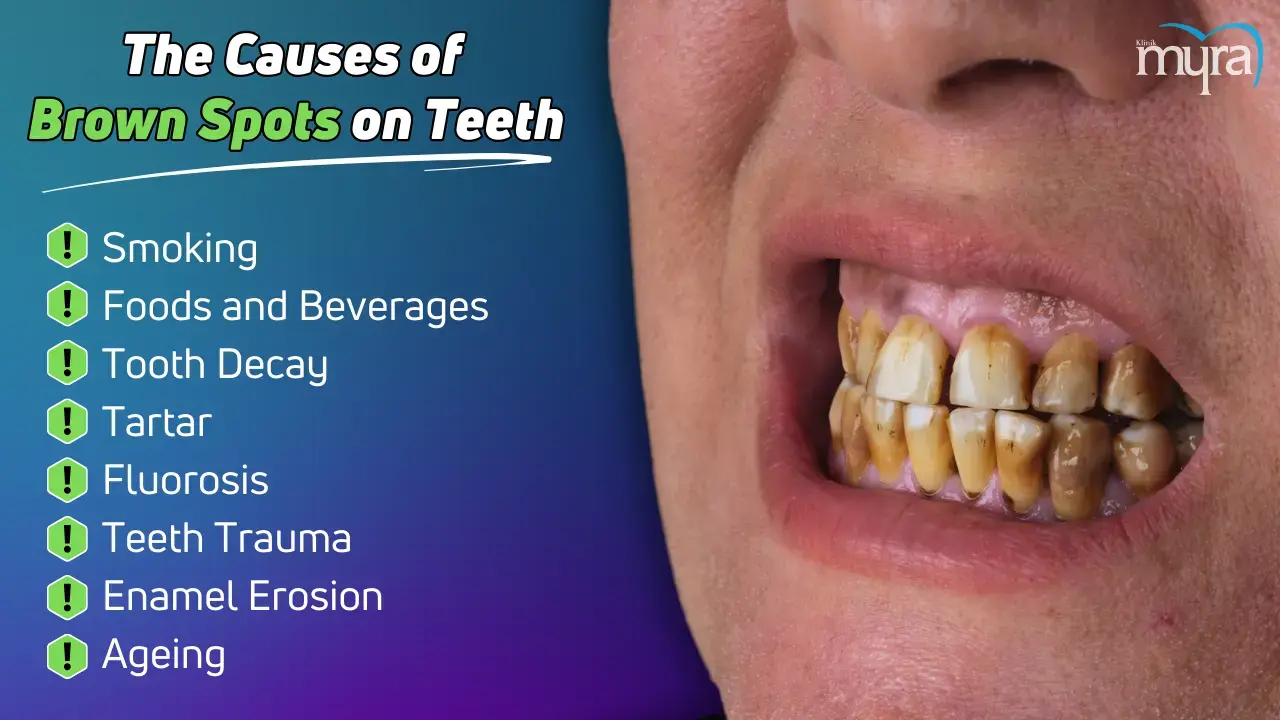
1. Smoking
Smoking involves the inhalation and use of tobacco products, including cigarettes, cigars, and pipes. Smoking leads to the buildup of nicotine and tar on tooth enamel, which adheres to the porous surface of the teeth. These substances penetrate the enamel, causing persistent and stubborn brown stains. Smokers are twice as likely to experience tooth discolouration compared to non-smokers. The frequency of smoking, the type of tobacco product used, and the effectiveness of oral hygiene practices all influence the severity of these stains. Quitting smoking is the most effective solution for preventing further discolouration and improving oral health.
2. Foods and Beverages
Foods and beverages are foods people consume, including drinks like coffee and tea and foods such as berries and tomato-based sauces. Foods and beverages cause brown stains on teeth due to their chemical composition. Drinks like coffee, tea, red wine, and certain fruit juices contain chromogens and tannins, which stain the tooth enamel. Acidic foods and drinks like cola and citrus juices erode enamel, making teeth more susceptible to staining. The substances adhere to the enamel over time, developing permanent brown spots. Reducing the intake of these items and maintaining good oral hygiene help prevent these stains.
3. Tooth Decay
Tooth decay occurs when acid and bacteria eat away at the tooth enamel, the tooth's protective outer layer. Tooth decay occurs when bacteria-filled plaque forms on the teeth and produces acids after consuming sugary foods. These acids break down the tooth enamel, leading to erosion. Continuous acid production causes cavities and brown stains if plaque is not regularly brushed off. The enamel wears away, revealing the yellowish-brown dentin below. It makes brown spots and discolouration visible on the teeth. Regular dental hygiene practices help prevent plaque buildup and tooth decay.
4. Tartar
Tartar, or calculus, is tooth plaque that has hardened and builds up on teeth and along the gum line. Regular flossing and plaque removal keep it from gathering between the teeth. Ignoring these factors leads to gradual plaque development and brown or yellow tartar. Tartar presents at the gum line and between teeth. Its presence causes brown streaks that roughen the surface and attract more staining agents and plaque. Reducing tartar calls for a professional dental cleaning. A thorough cleaning of the gums is necessary to eliminate the accumulation. Brushing and good dental care help to keep teeth white and stop tartar development.
5. Fluorosis
Fluorosis occurs when a person consumes an excessive quantity of fluoride while their teeth are developing. Excessive fluoride is not good, even though it is needed to keep teeth from getting cavities. Fluorosis appears as white, lacy markings on the teeth. It results in pits and brown spots on the enamel in severe cases. The brown spots occur because excessive fluoride disrupts the normal development of the enamel, leading to hypomineralisation and discolouration. Cosmetic or restorative dental procedures are necessary to treat fluorosis. These procedures repair the tooth's appearance by removing or covering the discolouration.
6. Teeth Trauma
Teeth trauma is physical injury or impact to the teeth that results from accidents, falls, or direct blows to the mouth. An injury to a tooth stains the dentin with blood, which changes the tooth's colour. It is commonly known as a tooth bruise. The internal bleeding causes the tooth to turn brown or grey. The discolouration sometimes fades over time, but in others, it persists. Pulp necrosis is when the tooth's nerve dies because of the trauma. It causes the tooth to turn a dark colour that is impossible to fix without root canal therapy, tooth whitening, crowns, or veneers. Consulting a dentist is essential to determining the most suitable treatment for trauma-induced tooth discolouration.
7. Enamel Erosion
Enamel erosion is the gradual wearing away or thinning of tooth enamel, the hard, protective outer layer of the tooth. The process occurs when acids in the mouth dissolve the minerals in the enamel, leading to its breakdown over time. Teeth take on a brownish colour due to the thinning enamel, which becomes more transparent and reveals the dentin's intrinsic yellowish or brownish hue. Eroded enamel is more porous and rough, making it easier for staining agents from food, drinks, and tobacco to penetrate and adhere to the tooth surface, resulting in brown spots or discolouration.
Enamel erosion weakens the tooth's protective layer, making it more vulnerable to decay. Brown spots on teeth are an indication of a cavity developing. The rougher surface created by eroded enamel is more prone to plaque buildup, which, when hardened into tartar, appears brown or yellow, contributing to tooth discolouration.Enamel erosion causes discolouration, as the loss of minerals from the enamel alters its optical properties, leading to brown or white spots. Proper oral hygiene and preventive measures are crucial to maintaining healthy enamel and preventing discolouration.
8. Ageing
Ageing is the natural process of growing older, characterised by physical, psychological, and social changes that occur over time. Ageing impacts the appearance and condition of teeth. One of the primary ways it causes brown teeth is through enamel thinning. The tooth's enamel wears away with time, revealing the naturally yellowish or brownish dentin. The thinning of enamel makes teeth appear darker. The dentin layer beneath the enamel naturally darkens with age. Teeth become browner because darker dentin shows through thinner, more translucent enamel.
Ageing leads to the accumulation of stains from various foods, drinks, and lifestyle habits. These stains become more pronounced, leading to brown spots or discolouration. Changes in tooth structure, such as microscopic cracks in the enamel, trap stains and lead to localised brown spots. Reduced saliva production with age contributes to discolouration, as saliva is crucial for neutralising acids and washing away food particles. The cumulative effect of long-term consumption of staining substances like coffee, tea, red wine, and tobacco products further exacerbates the browning of teeth over time. Maintaining good oral hygiene, regular dental check-ups, and professional teeth whitening treatments help minimise these age-related effects on tooth colour.
How Long does it take for a Tooth to go Brown?
The time it takes for a tooth to go brown depends on the cause, ranging from a few weeks in cases of trauma or decay to several years for enamel erosion and ageing. Regular dental check-ups and good oral hygiene help prevent or slow discolouration.
The nicotine and tar from cigarettes stick to the tooth enamel, which causes brown stains to appear within a few months for smokers. The exact time frame depends on the frequency and duration of smoking. Consuming dark-coloured foods and beverages like coffee, tea, red wine, and cola causes brown stains over several months to years, depending on the frequency of consumption and oral hygiene practices.
Brown spots from tooth decay develop relatively quickly, within weeks to months, if oral hygiene is poor and sugary foods and drinks are frequently consumed. The acids produced by plaque bacteria erode the enamel, leading to visible brown spots as decay progresses. Plaque hardens into tartar within a few days if not removed by regular brushing and flossing. Tartar quickly leads to brown or yellow discolouration along the gum line.
Dental fluorosis occurs during tooth development in childhood due to excessive fluoride intake. Brown spots or streaks become apparent when the affected teeth erupt by age eight. Discoloration from trauma happens within days to weeks after an injury. Blood from internal bleeding causes the tooth to turn brown or grey relatively quickly.
Enamel erosion and subsequent discolouration take several years, depending on dietary habits, exposure to acidic substances, and oral care. The tooth's underlying structure darkens as the enamel wears away, revealing dentin. The natural darkening of teeth due to ageing has been a slow process for decades. Enamel thinning, dentin darkening, and cumulative exposure to staining agents contribute to gradual changes in tooth colour.
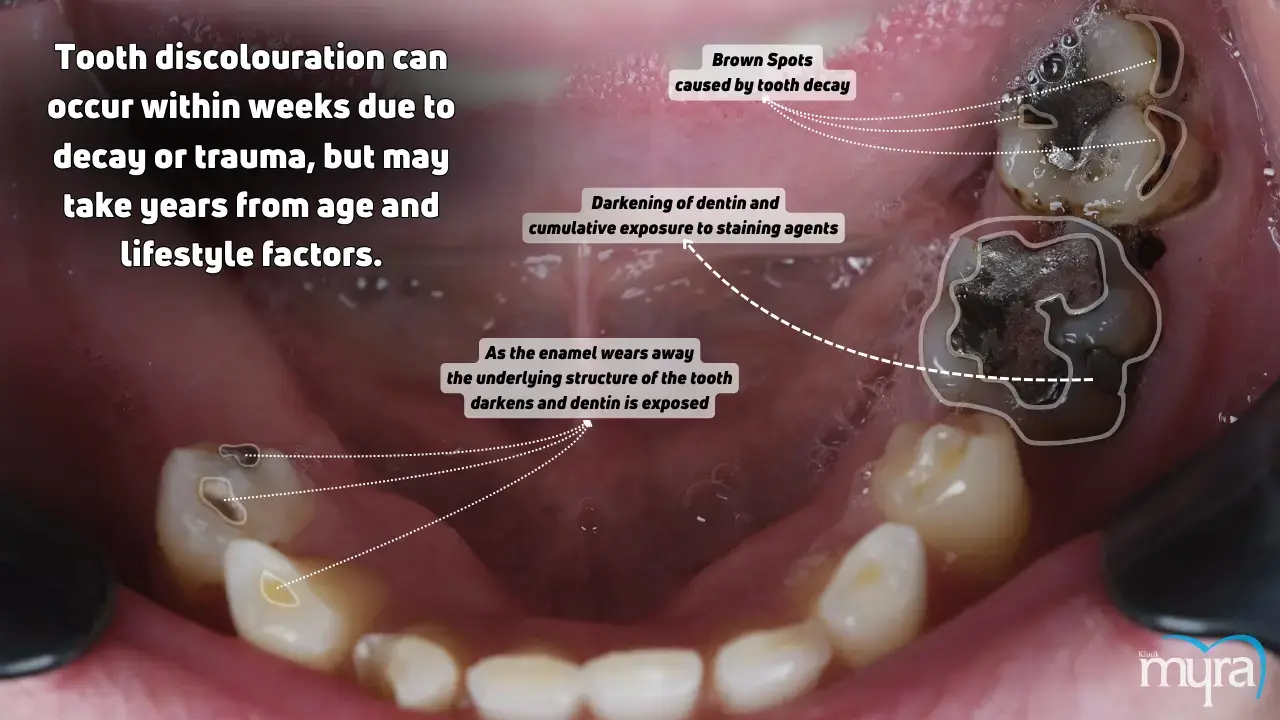
What are the Symptoms of having a Brown Tooth?
The symptoms of having a brown tooth are not limited to discolouration, as they indicate various underlying dental issues, such as brown spots. The spots on teeth result from tooth decay, tartar buildup, enamel erosion, or staining from foods and beverages. Common symptoms accompanying these spots include tooth pain, sensitivity, and bad breath. Untreated tooth decay progresses to gingivitis in severe cases, causing the gums to bleed or feel sore consistently. Individuals with celiac disease experience additional oral symptoms like dry mouth, canker sores, mouth ulcers, and a very red, smooth, and shiny tongue. Enamel hypoplasia results in a rough texture or pitted areas on teeth that present as brown spots.
Understand that the absence of pain does not necessarily indicate that everything is fine. Seek help if there is a “brown spot on tooth no pain.” Brown spots develop into more serious dental issues over time if left untreated. Visit a dentist to find out what is causing a brown spot on a tooth, even if it does not hurt, to get the treatment needed and maintain good oral health in the long run.
What are the Complications of Having Brown Spots on Teeth?
The complications of having brown spots on teeth are listed below.
- Tooth Decay and Cavities: Brown spots on teeth signal the early stages of tooth decay or cavities. Tooth decay spreads and weakens the tooth's structure if not treated quickly. The progression leads to severe pain, increased sensitivity, and the need for more extensive dental procedures such as fillings, root canals, or even extractions.
- Gum Disease: Discoloration accompanies symptoms such as gum bleeding, sensitivity, pain, or bad breath. Tooth decay worsens and causes gingivitis, a common gum disease if the root cause is untreated. Untreated gingivitis progresses to periodontitis, a more severe form of gum disease that compromises the health of the teeth and gums and even causes other systemic issues.
- Oral Symptoms of Celiac Disease: Brown spots on teeth are an early oral symptom for individuals with celiac disease. These spots are accompanied by other symptoms such as dry mouth, canker sores, mouth ulcers, a very red and smooth tongue, and even evidence of oral cancer. These oral manifestations require careful monitoring and management to prevent further complications.
- Effects of Enamel Hypoplasia: Teeth affected by enamel hypoplasia, resulting in thin and pitted enamel, have a rough texture and brown or yellow discoloured spots. Enamel hypoplasia increases tooth wear and tear, leaving teeth more vulnerable to mechanical damage and decay. The condition impacts the teeth' structural integrity and aesthetic appearance.
- Increased Risk of Tooth Loss: Prolonged neglect of brown spots and their underlying issues lead to the eventual loss of affected teeth. Tooth loss has a cascade of adverse effects, including difficulty eating and speaking, shifting of remaining teeth, and potential bone loss in the jaw, which alter facial structure and function.
- Systemic Health Issues: Oral health is closely linked to health. Conditions like severe periodontitis, which arise from untreated brown spots and related gum disease, have been associated with systemic health problems such as cardiovascular disease, stroke, and complications during pregnancy.
- Social and Psychological Impact: Brown spots on teeth have a significant social and psychological impact. Visible dental discolouration affects a person's self-esteem and confidence, potentially leading to social anxiety and reduced quality of life. Addressing these issues through appropriate dental care improves oral health and well-being.
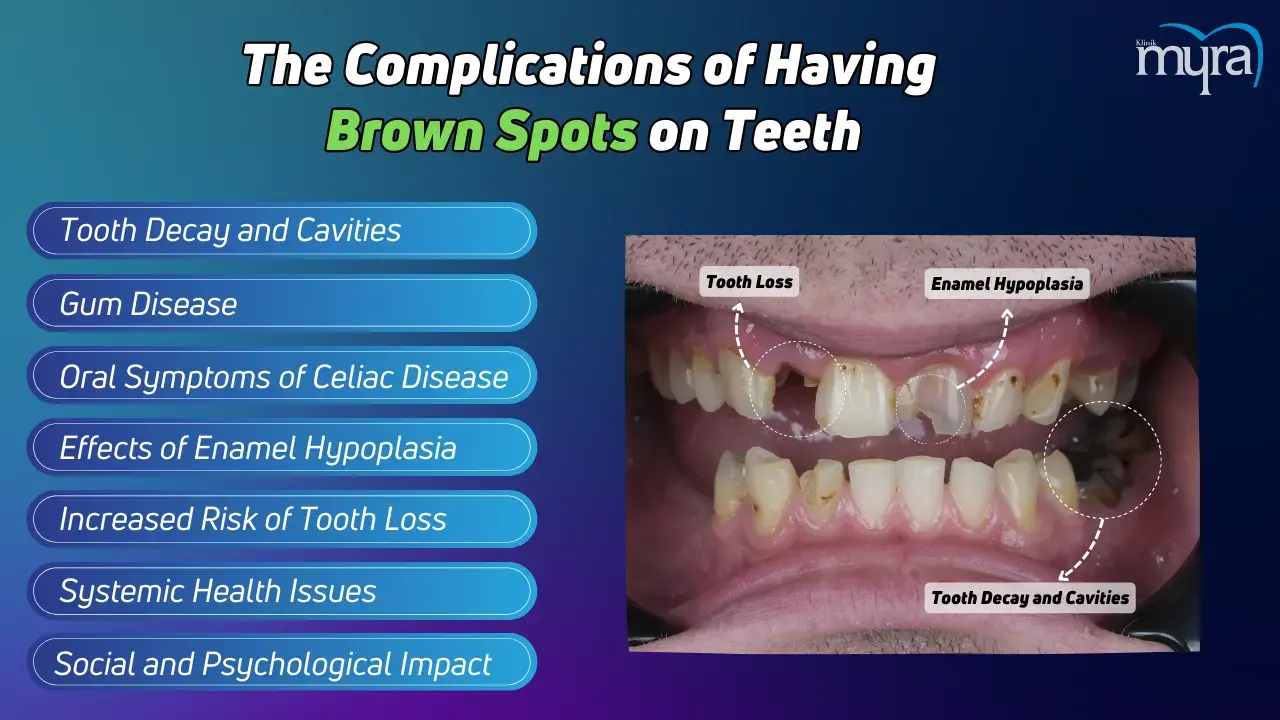
What are the Treatments for Brown Spots on Teeth?
The treatments for Brown Spots on teeth are listed below.
- Dental Bonding: Dental bonding involves applying a tooth-coloured resin material to the teeth to correct imperfections. The resin is applied and shaped to match the natural tooth, then hardened with a special light. Dental bonding is a versatile treatment for covering brown spots, filling cavities, and repairing chipped or cracked teeth. It is less invasive and more cost-effective than veneers and crowns, though it is not very durable.
- Whitening Treatments: Whitening treatments involve using bleaching agents to lighten the colour of the teeth. These treatments are done at home with over-the-counter products or professionally by a dentist. Professional whitening involves more vital bleaching agents and specialised equipment to remove surface stains and deeper discolourations.
- Dental Veneers: Dental veneers are thin, custom-made shells covering the teeth' front surface. They are made from porcelain or dental resin and bonded to the teeth to improve their colour, shape, and appearance. Veneers are an effective solution for covering brown spots and other discolourations when whitening treatments are insufficient.
- Dental Crowns: Dental crowns are caps placed over damaged or discoloured teeth to restore their shape, size, and appearance. Crowns are custom-made to fit over the entire visible portion of the tooth. They are used when a tooth is extensively damaged or discoloured and not effectively treated with veneers or whitening. Crowns are constructed from various materials, including porcelain, metal, or a combination.
1. Whitening Treatments
Whitening treatments lighten the colour of the teeth and remove discolouration by employing high-concentration bleaching substances delivered under dental supervision. These treatments target and break down the molecules, causing discolouration in the enamel and dentin. Bleaching agents, such as carbamide or hydrogen peroxide, lighten stains by penetrating the tooth surface and reacting chemically.
Activated by a specific light, a high-concentration bleaching gel is applied to the teeth during in-office whitening, resulting in rapid and noticeable whiter teeth. The method takes an hour and whitens teeth in a single session. Dental professionals provide their patients with at-home whitening trays that are custom-fitted and filled with bleaching gel at a lower concentration. These trays are worn daily for several weeks, allowing gradual tooth whitening. Laser whitening, an innovative technique that uses light to activate a bleaching gel, produces faster and more noticeable results than conventional in-office whitening. The laser enhances the effectiveness of the bleaching agent, resulting in quicker and more intense whitening.
Professional teeth whitening is highly effective for treating brown stains on teeth staining caused by external factors like food, drinks, and smoking. The effectiveness of the teeth whitening varies depending on the cause and severity of the stains. Intrinsic stains, deeper and caused by variables such as medication or fluorosis, require additional treatments such as veneers or crowns. A dentist may sometimes recommend using retainers or night guards.
2. Dental Veneers
Dental veneers are thin, custom-made shells made of porcelain or dental resin that cover the front of teeth to make them look better. Veneers cover discoloured teeth with a new look that matches the desired colour and shape. The procedure involves removing a small amount of enamel from the tooth's surface, taking an impression of the tooth, and then creating a veneer that fits perfectly over the tooth. The adhesive attached to the tooth determines a veneer's ability to conceal discolouration and impart a white, natural sheen.
Veneers are custom-made to match the surrounding teeth' colour, shape, and size, ensuring a seamless and natural look. Porcelain veneers are highly durable and resistant to staining, making them a long-lasting solution for discoloured teeth.
Veneers are multipurpose because they hide discolouration, fix misaligned teeth, large spaces between teeth, and irregular shapes and sizes. The procedure requires minimal removal of tooth enamel compared to other treatments like crowns.
Dental veneers are highly effective for treating brown stains on teeth. They immediately improve tooth colour and completely mask discolouration caused by various factors, including intrinsic stains not responsive to whitening treatments. Veneers are a popular choice in cosmetic dentistry due to their ability to enhance the appearance of a smile. A dentist may sometimes recommend using retainers or night guards.
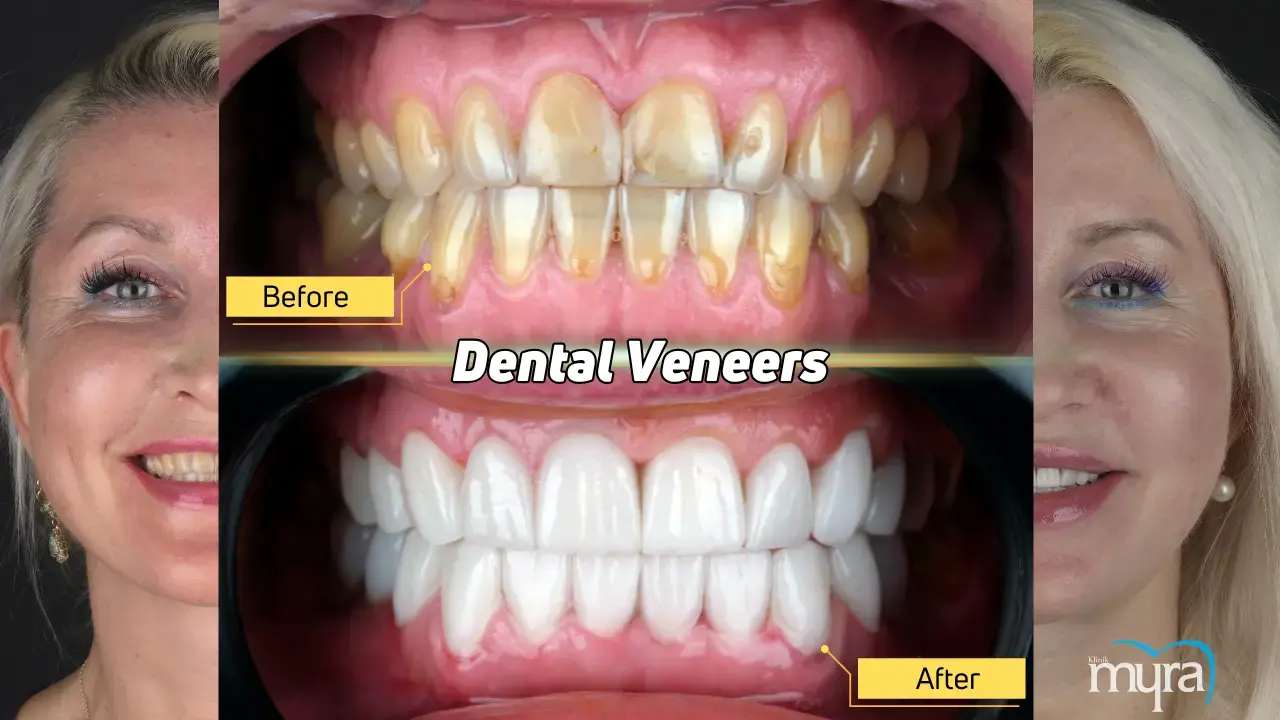
How much is a Dental Veneer in Turkey?
Dental veneers in Turkey cost from £220 to £300 or $284 to $387 per tooth. Veneers in Turkey are cheaper than in many European countries and the USA, making it an attractive destination for dental tourism. It is considerably lower compared to the UK, where porcelain veneers range from £500 to £1,000 per tooth ($645 to $1,290) and dental veneers from £150 to £400 per tooth ($194 to $516).
Dental veneers cost between $250 and $1,500 per tooth (£194 to £1,162) in the United States, whereas porcelain veneers cost between $925 and $2,500 per tooth (£717 to £1,937). Zirconium veneers in the USA are priced around $1,000 to $2,000 per tooth (£775 to £1,550), and Lumineers range from $800 to $2,000 each (£620 to £1,550).
The number of teeth that need veneers, the material type and quality, the dentist's expertise, and the clinic's facilities are some of the variables that affect the price of dental veneers in Turkey. Prices vary between cities, with Antalya being more economical than Istanbul. Turkish clinics offer all-inclusive packages that cover accommodation, transportation, and meals, further enhancing the cost-effectiveness of getting dental veneers in Turkey.
Send images of the teeth to dental offices in Antalya for precise pricing estimates. Turkey offers competitive and affordable prices for dental veneers compared to many European countries and the USA, making it a top pick for patients seeking quality dental care at lower costs. A dentist may suggest retainers or night guards to protect veneers and prolong their lifespan.
3. Dental Crowns
Dental crowns are caps covering a tooth's entire visible portion over the gum line. They fix a tooth's size, look, shape, and strength. Dental crowns are an excellent way to fix teeth that are severely stained or brown. The process involves preparing the tooth by removing a portion of the enamel and any decay. A custom crown is made by taking an impression of the prepared tooth. A temporary crown is placed until the one that is permanent is prepared. The tooth is prepared for the permanent crown by bonding it to the tooth using materials that closely resemble the tooth's natural enamel. It covers up the discolouration entirely and gives the tooth its natural look again.
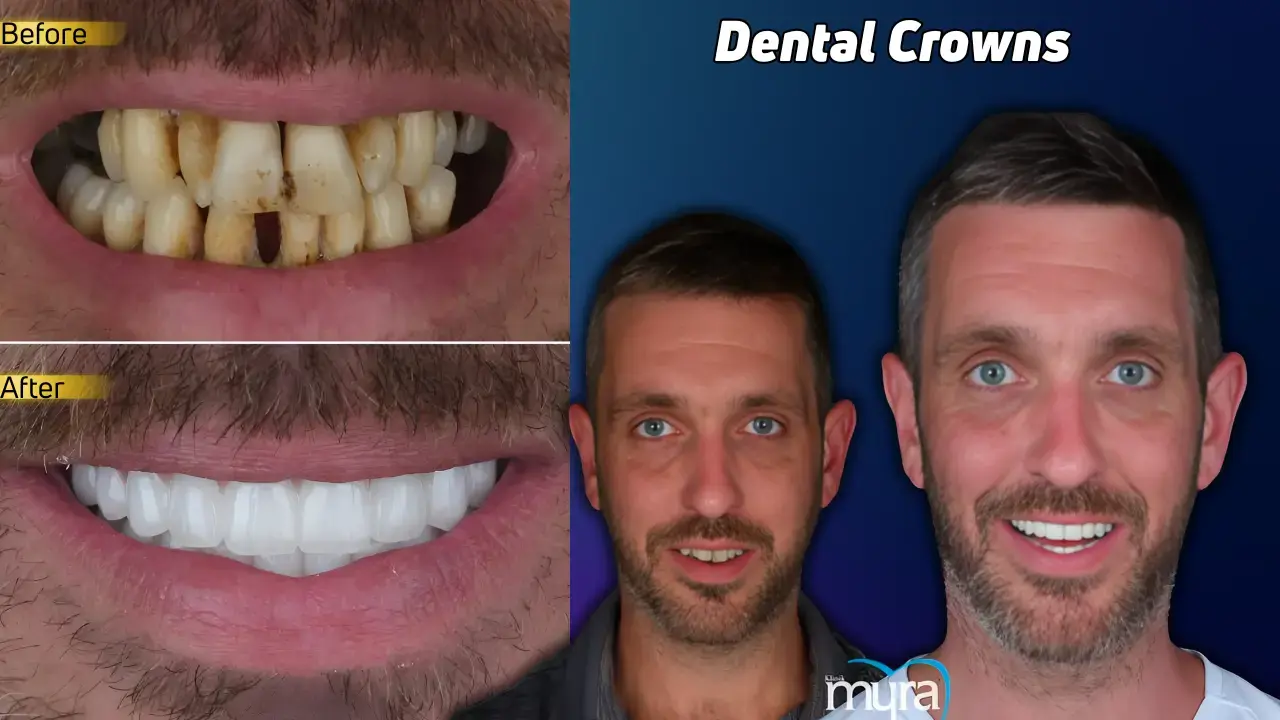
How much is a Dental Crown in Turkey?
Dental crowns in Turkey are more affordable than in the UK and the USA. A porcelain crown costs £140 ($181), a zirconium crown costs £210 ($271), an E.MAX crown costs £265 ($342), and a Celtra crown costs £300 ($387). The prices make Turkey an attractive destination for patients seeking high-quality dental care at a lower cost.
The dental crown price in the United Kingdom varies from £600 to £1,000 (about $774 to $1,290). The price varies based on the type of material used and the complexity of the treatment. Premium materials and specialised treatments push the cost even higher, making dental crowns a significant investment for patients in the UK.
The average dental crown cost in the United States is between $388 and £2,326 (or $500 to $3,000 per tooth). Porcelain crowns cost between $800 and $3,000 per tooth (£620 to £2,326), while porcelain fused to metal crowns range from $800 to $1,400 per tooth (£620 to £1,085). Metal crowns fabricated from gold alloy cost between $800 and $2,500 (£620 to £1,937). The prices reflect the higher cost of dental care in the USA.
Turkey's considerable cost savings, coupled with the availability of high-quality dental services, make it a popular destination for dental tourism. Many patients travel to Turkey for dental treatments, taking advantage of the lower prices while receiving care from experienced professionals. Dentists sometimes recommend using retainers or night guards to protect crowns and prolong their lifespan.
4. Dental Bonding
Dental bonding, or composite bonding, is a cosmetic procedure that covers stained teeth or broken teeth with tooth-coloured resin. The material is then hardened, shaped, and polished to improve the teeth's appearance.
Dental bonding is an excellent option for people with discoloured brown teeth because it involves hiding a tooth-coloured resin on the discolouration. The dentist shapes the dental material to match the natural contours of the tooth and blend seamlessly with adjacent teeth. The resin material is chemically bonded to the tooth enamel, ensuring a solid and durable attachment. The dental material is carefully selected to match the shade of the surrounding teeth, creating a natural-looking result.
Dental bonding requires minimal or no removal of tooth structure, making it a conservative and non-invasive treatment. The procedure is completed in a single appointment, allowing immediate improvements in the teeth' appearance. The bonded resin has an average lifespan of 3-7 years, depending on the patient's home care and oral hygiene practices.
Dental bonding provides excellent aesthetic results, providing a natural look that blends well with the surrounding teeth. It is easily repaired if the bonded area becomes damaged or discoloured over time. Dental bonding is less invasive than other options, like porcelain veneers, making it suitable for patients seeking a less intensive procedure. It is a cost-effective solution for improving the appearance of teeth, making it accessible to a broader range of patients.
Dental bonding is adequate for brown teeth when discolouration is mild to moderate. It is a suitable option when tooth whitening alone is insufficient to achieve the desired results. Dental bonding is ideal for patients who prefer a minimally invasive treatment option, expect immediate results, or want a reversible or temporary solution before considering more permanent options like porcelain veneers. The effectiveness of dental bonding for brown teeth varies depending on the severity and cause of the discolouration. Porcelain veneers are one alternative treatment option that suits some patients, especially patients with deep or intrinsic stains.
Consult a dental professional who assesses the specific case and recommends the most appropriate treatment option. Maintaining good oral hygiene and avoiding staining substances help prolong the life and effectiveness of dental bonding for brown teeth. A dentist sometimes recommends using retainers or night guards to protect the bonded teeth and prolong their lifespan.
Can Brown Teeth be Treated at Home?
Yes, brown teeth can be treated at home, but the effectiveness of home treatments depends on the cause and severity of the discolouration. Apple cider vinegar has natural whitening properties, and brushing the teeth with it helps remove stains. Turmeric is used to make a paste with turmeric powder and water. Applying it to the teeth helps whiten them over time. Coconut oil pulling involves swishing coconut oil in the mouth for 15-20 minutes, which helps remove bacteria and stains from the teeth. Baking soda is used by brushing with baking soda and water to scrub away surface stains. Hydrogen peroxide is another option. Using a diluted hydrogen peroxide solution as a mouthwash or mixing it with baking soda helps whiten teeth by killing bacteria and bleaching stains.
Whitening toothpaste helps reduce surface stains on teeth, as the toothpaste contains mild abrasives and sometimes small amounts of peroxide to help remove stains. Baking soda is a mild abrasive that helps scrub away surface stains, and mixing it with water to form a paste is effective for lightening brown spots. Hydrogen peroxide, a bleaching agent, is used as a mouth rinse or mixed with baking soda to create a paste to reduce brown spots. Activated charcoal binds to stains and helps remove them from the tooth surface, and brushing with activated charcoal powder helps lighten stains. Oil pulling with coconut oil for 10-15 minutes removes toxins and stains, improving oral hygiene.
Surface stains from foods, drinks, and smoking tend to be the most amenable to home remedies, though they work for mild to moderate stains. These at-home remedies have the potential to be enough to remove intrinsic stains that are deep in the tooth or caused by things like fluorosis, specific drugs, or cavities. A trip to the dentist is for more severe discolouration or stains that refuse to respond to at-home remedies. Professional dental treatments such as teeth whitening, veneers, or crowns are unnecessary to achieve the desired results.
Does Brown Teeth Heal on its own in Children?
No, brown teeth do not heal on their own in children. The increased presence of dentin causes the natural tooth colour of emerging adult teeth to appear more yellow or brownish than that of baby teeth. It is a normal part of dental development. Actual brown discolouration resulting from stains, decay, or other dental issues does not resolve without intervention.
Dentin is inherently yellow and more visible through the thinner enamel of new teeth, which is why adult teeth, when first erupted, seem more yellowish or brownish than baby teeth. The teeth lighten as they are exposed to various elements and daily wear. The natural colour change is not a sign of a problem and does not require treatment.
Spots or discolouration a child has due to tooth decay, inadequate dental hygiene, or food habits do not go away independently. For example, tooth decay results from bacterial activity that damages the enamel and dentin, leading to cavities and discolouration. The decay worsens and causes pain if it does not get regular dental care.
What are the Strategies for Preventing Brown Spots on Teeth?
The strategies for preventing brown spots on teeth are listed below.
- Using Fluoride Toothpaste: Using toothpaste that contains fluoride strengthens tooth enamel, protects teeth from decay and reduces the risk of developing brown spots.
- Limiting Staining Foods and Beverages: Reducing the consumption of foods and drinks known to stain teeth, such as coffee, tea, red wine, and berries, prevents their pigments from adhering to the enamel and causing discolouration.
- Regular Dental Check-ups and Cleanings: Visiting the dentist at least twice yearly for professional cleanings and examinations helps remove plaque and tartar. Regular brushing and flossing and early detection of issues prevent serious problems.
- Drinking Water After Meals: Rinsing the mouth with water after eating or drinking helps wash away food particles and staining substances, reducing the risk of stains forming on teeth.
- Regular Brushing and Flossing: Brushing twice daily and flossing daily help remove plaque and food particles. They prevent plaque buildup, which leads to stains and tooth decay.
- Using a Straw for Beverages: Drinking staining beverages through a straw minimises contact between staining liquids and teeth, reducing the risk of discolouration.
- Eating Crunchy Fruits and Vegetables: Consuming raw, crunchy fruits and vegetables like apples, carrots, and celery helps scrub the teeth naturally, removing surface stains and promoting saliva production, which cleanses the mouth.
- Avoiding Tobacco Products: Refraining from smoking or using other tobacco products prevents teeth staining and other oral health issues, helping maintain whiter teeth and better oral health.






